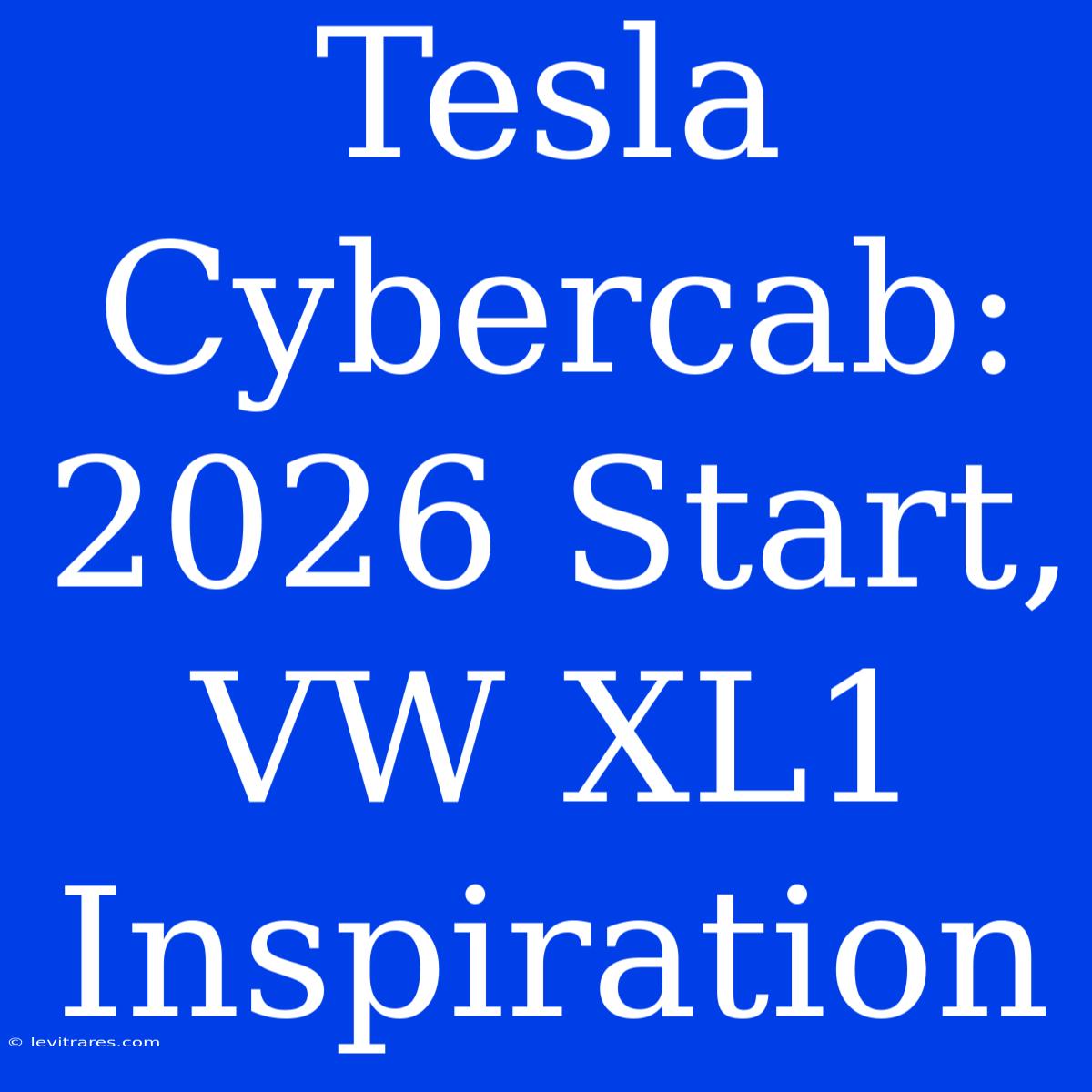Tesla Cybercab: 2026 Start, VW XL1 Inspiration - A Glimpse into the Future of Electric Mobility
Is Tesla planning a radical shift in urban transportation with an all-electric, self-driving taxi service? The rumor mill is buzzing about the Tesla Cybercab, a proposed robo-taxi envisioned to launch in 2026, drawing inspiration from the revolutionary fuel-efficiency of the VW XL1.
Editor Note: This article explores the tantalizing possibilities of the Tesla Cybercab, a futuristic self-driving taxi that could transform urban transportation.
This topic is important to understand as it touches upon the intersection of electric vehicles, autonomous driving, and ride-hailing services. By analyzing the potential of the Cybercab, we can gain insight into the future of transportation and its impact on urban landscapes, traffic management, and environmental sustainability.
Our analysis delves into the key aspects of the Tesla Cybercab:
- Inspiration from the VW XL1: Understanding how the groundbreaking fuel efficiency of the VW XL1 might influence the design and technology of the Cybercab.
- Self-Driving Capabilities: Examining the potential of autonomous driving technology in the Cybercab, its impact on safety and user experience.
- Electric Powertrain: Assessing the advantages of an all-electric powertrain in the Cybercab, particularly its environmental impact and cost-effectiveness.
- Fleet Deployment: Exploring the challenges and opportunities of deploying a fleet of self-driving Cybercabs, including infrastructure needs and regulatory considerations.
Key Aspects of the Tesla Cybercab:
| Feature | Description |
|---|---|
| VW XL1 Inspiration | Focus on maximizing efficiency through aerodynamic design and lightweight construction. |
| Self-Driving Technology | Utilizing advanced sensors and AI for autonomous navigation and safety. |
| Electric Powertrain | Leveraging battery technology for zero-emission mobility. |
| Fleet Deployment | Scaling up to a large fleet with efficient management and maintenance. |
Tesla Cybercab: A Vision of the Future
VW XL1 Inspiration: Efficiency at the Forefront
The Tesla Cybercab's design might take cues from the VW XL1, a hyper-efficient vehicle renowned for its aerodynamic prowess and lightweight construction. This approach prioritizes fuel economy (in this case, energy efficiency) by minimizing drag and reducing overall weight. The Cybercab could benefit from this philosophy, potentially offering a more sustainable and cost-effective ride-hailing experience.
Self-Driving Capabilities: Revolutionizing Mobility
The Cybercab's core functionality hinges on autonomous driving technology. Advanced sensors, including LiDAR, cameras, and radar, could provide a comprehensive view of the surrounding environment, enabling the Cybercab to navigate safely without human intervention. This would not only enhance passenger safety but also potentially reduce traffic congestion and accidents.
Electric Powertrain: A Clean and Efficient Solution
The Cybercab, being fully electric, would offer a clean and efficient alternative to traditional combustion engine vehicles. This aligns with Tesla's commitment to sustainable transportation. The lack of tailpipe emissions would contribute to cleaner air quality in urban environments, potentially reducing health risks associated with pollution.
Fleet Deployment: Scaling Up for Mass Adoption
Deploying a fleet of Cybercabs would require a robust infrastructure to support charging, maintenance, and management. Establishing dedicated charging stations and efficient maintenance protocols would be crucial for ensuring the smooth operation of the fleet. Furthermore, regulatory frameworks for self-driving vehicles would need to evolve to accommodate the widespread adoption of Cybercabs.
FAQ: Tesla Cybercab
Q: Is the Tesla Cybercab confirmed? A: There has been no official confirmation from Tesla regarding the Cybercab. However, speculations and rumors persist, making it a topic of considerable interest.
Q: What is the estimated cost of the Tesla Cybercab service? A: It's too early to estimate the cost of the Cybercab service. However, factors like battery technology, maintenance costs, and the potential for self-driving automation will influence pricing.
Q: Will the Tesla Cybercab operate in all cities? A: The initial launch of the Cybercab might be limited to specific cities with favorable regulatory frameworks and infrastructure. Expansion to other cities will depend on the success of the initial rollout and the adoption of autonomous driving technology.
Q: What are the safety implications of self-driving Cybercabs? A: While autonomous driving technology holds immense promise for enhanced safety, challenges remain. Extensive testing and development are essential to ensure the reliability and robustness of self-driving systems in diverse and unpredictable real-world scenarios.
Q: How will the Tesla Cybercab affect employment in the transportation sector? A: The widespread adoption of self-driving Cybercabs could lead to job displacement in traditional taxi and ride-sharing services. However, new job opportunities could emerge in the development, maintenance, and management of autonomous vehicle technology.
Tips for Understanding the Tesla Cybercab
- Stay informed about Tesla's announcements and developments.
- Follow industry experts and analysts for insights into the future of autonomous driving.
- Engage with discussions about the ethical and societal implications of self-driving technology.
- Explore resources on electric vehicle technology and the future of transportation.
Summary
The Tesla Cybercab, while still in the realm of speculation, represents a potential game-changer in urban transportation. It combines the efficiency of the VW XL1, the promise of autonomous driving, and the environmental benefits of electric powertrains. The success of the Cybercab will depend on technological advancements, regulatory frameworks, and public acceptance of autonomous driving technology. This exploration has illuminated the key aspects of this intriguing concept, providing a glimpse into a future where electric and self-driving vehicles transform the way we move around our cities.
Closing Message: The Tesla Cybercab, if realized, could usher in a new era of mobility, offering safe, clean, and efficient transportation for urban dwellers. As the future unfolds, we can anticipate further developments in autonomous driving, electric vehicles, and the potential for revolutionary transportation solutions like the Cybercab.

